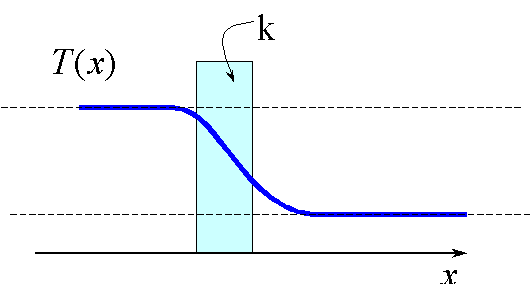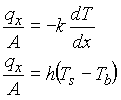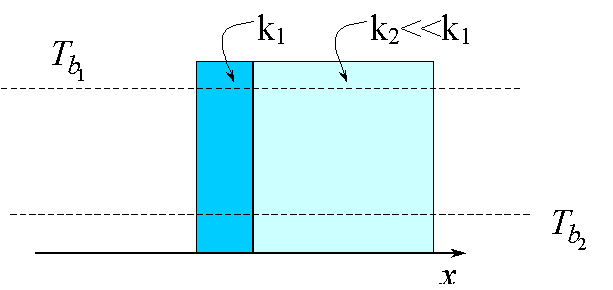Return
to Homework Page | Return
to CM310 Home Page
Heat Transfer Review
Questions:
F. A. Morrison
CM310
November 12, 1999
-
For heat flux through a slab, the temperature profile is measured to be
as shown below. On which side is the heat-transfer coefficient larger,
the left or the right? Why? Justify your answer mathematically.

-
Explain why the temperature profile in a slab is linear when the flux is
constant.
-
Why do we use DTlm for double-pipe
heat exchangers?
-
Where does the equation Q=UADTm come
from? What is DTm?
-
If I double the velocity of the fluid that is flowing in laminar flow in
a pipe, how will the heat-transfer coefficient change?
-
What is heat exchanger effectiveness? When is it useful?
-
What's the big deal with significant figures? Is it just a way to deduct
points or does it have an importance to engineers?
-
Is the following a correlation for forced or for natural convention? How
do you know? (you should be able to answer almost instantly, without looking
for this correlation in the book)

-
Please describe how you would measure the overall heat transfer coefficient
on a heat exchanger. Indicate what data you would take and how you would
calculate U.
-
For heat flux in concentric pipes with heat generation, we calculated that
the flux proportional to radial position, r. Why does qr/A
increase with r?
-
What is the Peclet number? Where does it come from?
-
What is the Prandtl number? Where does it come from?
-
What is the Grashof number? Where does it come from?
-
Why are the heat-transfer coefficients, h, in film boiling higher
than in nucleate boiling?
-
Why are the heat-transfer coefficients, h, higher in dropwise condensation?
-
What is the advantage of a shell-and-tube heat exchanger over a double-pipe
heat exchanger? Why not just stick with the simpler double-pipe exchanger?
-
If a heat exchanger has effectiveness, e = 1,
what does that mean?
-
Which has a larger capacity, single-effect or double-effect evaporators?
(be careful in answering)
-
List the different types of evaporators we have studied. What are the differences
among the designs? What kind of heat transfer takes place inside the evaporators?
e.g forced convection? natural convection? radiation?
-
Geankoplis 4.1-2 (Determination of thermal conductivity)
-
What is the equation that defines heat-transfer coefficient, h?
-
Geankoplis 4.3-1 (Insulation needed for a food storage room)
-
In the Process Simulation and Control Center at Michigan Technological
University they have a reactor that makes a polymer called polydimethylsiloxane.
The reactor is heated through a jacket through which a heat-transfer fluid,
Dow Syltherm®, circulates. The jacket-reactor system acts like a 1-1
shell-and-tube heat exchanger. The Syltherm® inlet temperature is found
to be 210oC, and the outlet temperature is 190oC.
The reaction mixture is well mixed and at the time of interest it is at
a temperature of 160oC. The heat capacity of the Syltherm®
is xx kJ/kg K and the mass flow rate is yy kg/min. What is the product
UA (overall heat-transfer coefficient times area) for the reactor? (I didn't
have time to get these numbers, but could you do the problem if I supplied
them?)
-
Geankoplis 4.3-4 (Heat loss from a steam pipeline)
-
Geankoplis 4.3-9 (Heat loss from temperature measurements)
-
Geankoplis 4.3-11 (Find center-line temperature at steady state for heat
transfer with heat generation)
-
Geankoplis 4.5-4 (Heating water with hot gas and heat-transfer area)
-
Geankoplis 4.7-1 (Calculate natural convection heat-transfer coefficients)
-
Geankoplis 4.8-1 (Calculate boiling heat-transfer coefficients in a jacketed
kettle)
-
Geankoplis 4.10-2 (Calculate heat-transfer rate to a loaf of bread due
to radiation)
-
Geankoplis 4.10-4 (Calculate heat-transfer rate to a loaf of bread due
to radiation and due to conduction)
-
Geankoplis 5.2-1 (Unsteady state heat transfer: time for the temperature
in a wire to drop to half its initial value) You may assume that the thermal
conductivity of the wire is high and that therefore there is no internal
resistance to heat transfer.
-
The temperature profile through a material of conductivity k is
measured and is fit to the equation listed below:

 where x is the coordinate position through the material in meters,
and T is the temperature in oC. What is the heat
flux through this material? If the same temperature profile were measured
in a material with a thermal conductivity of 2k, what would the
flux be?
where x is the coordinate position through the material in meters,
and T is the temperature in oC. What is the heat
flux through this material? If the same temperature profile were measured
in a material with a thermal conductivity of 2k, what would the
flux be?
-
We have at least two different equations for qx/A, given
below. What is the difference between the two equations? When do we use
one versus the other? What kinds of heat transfer do they represent?

-
When do we used the microscopic energy balance (given below in Gibbs notation)
compared to the macroscopic energy balance (also given below)


-
A very large cube of frozen spinach is removed from the freezer and is
placed on the counter in the kitchen. What physical properties of the spinach
will determine the time it will take to completely thaw the cube?
-
Immediately after the dishwasher cycle ends, you open the door, and look
inside. Metal bowls are dry; plastic bowls, however, are beaded with water.
Using the heat-transfer concepts we have been discussing, explain why the
plastic bowls are not dry.
-
A wall is insulated with a layer of material with a low thermal conductivity.
Sketch the temperature profile on the diagram below, and label your answer,
giving the reasons for each of the features on the diagram.

-
A manufacturer makes a cookie sheet called Air Bake®. These cookie
sheets consist of two metal plates with air trapped in between. The manufacturer
claims that you will never burn your cookies if you buy this higher-priced
product. Explain, using the heat-transfer concepts you have been studying,
why this is true or not.
-
On late-night television a salesman with an English accent is trying to
sell you a device that is some kind of "turbo cooker". The turbo cooker
will cook food many times faster than your conventional oven and is even
faster than the microwave oven. The turbo cooker circulates hot air around
the food to cook it. Explain, using the heat-transfer concepts you have
been studying, how the turbo cooker works. Explain also how a microwave
oven works. What determines which is faster, the turbo cooker or the microwave
oven?
-
Cooking a single potato in a microwave oven is very fast, taking about
4 minutes. Cooking two potatoes, however, takes about 8 minutes. In a conventional
oven cooking from 1 to 10 potatoes takes the same amount of time. Why does
the microwave take twice as long to cook 2 potatoes but the conventional
oven takes the same amount of time no matter how many potatoes?
-
Which is more effective, co-current or counter-current flow in a heat exchanger?
Why?
-
How does dimensional analysis assist us in understanding heat transfer?
-
What is the Nusselt number? Where did it come from? How is it used?
-
The heat flux out of a pipe is 3050 W/m2. After the pipe is
insulated, is the flux higher, lower, or the same?
Return
to Homework Page | Return
to CM310 Home Page






